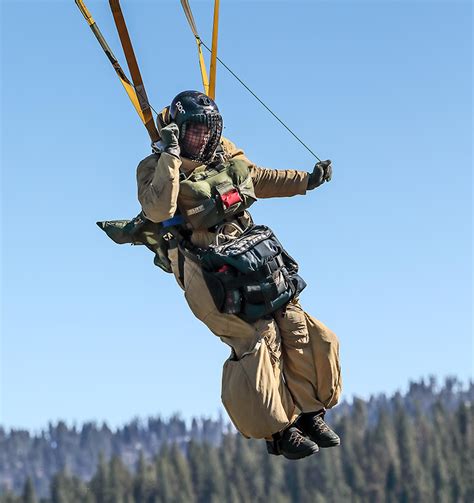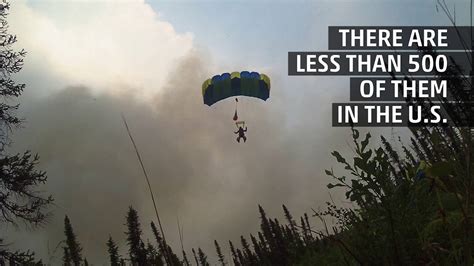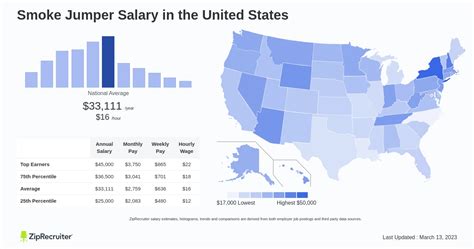For those who seek a career that combines elite physical conditioning, mental fortitude, and a profound sense of purpose, the role of a smokejumper is an unparalleled calling. These highly specialized wildland firefighters parachute into remote, rugged terrain to combat wildfires in their earliest stages. But beyond the adrenaline and dedication, what is the financial reality of this demanding profession?
While the path is arduous, the compensation for a smokejumper is competitive, reflecting the immense skill and risk involved. A smokejumper's total annual earnings can range significantly, typically falling between $50,000 and $95,000, with the most experienced leaders potentially exceeding $120,000 during a particularly intense fire season. This article breaks down the components of a smokejumper's salary, the factors that influence it, and the outlook for this critical profession.
What Does a Smokejumper Do?

Before diving into the numbers, it's essential to understand the job's unique demands. Smokejumpers are the "special forces" of wildland firefighting. Employed primarily by the U.S. Forest Service (USFS) and the Bureau of Land Management (BLM), their core mission is initial attack. They are transported by aircraft and parachute into areas inaccessible by road to contain fires while they are still small.
Once on the ground, they are entirely self-sufficient for up to 72 hours, carrying food, water, and firefighting tools. Their work involves constructing firelines, felling trees, and managing the fire's spread until ground crews can arrive or the fire is suppressed. It is a job that demands peak physical fitness, expert knowledge of fire behavior, survival skills, and unwavering teamwork.
Average Smokejumper Salary

A smokejumper's pay is more complex than a simple annual salary. As federal employees, their compensation is structured around the General Schedule (GS) pay scale, combined with significant supplemental pay.
The base salary for a smokejumper typically falls within the GS-5 to GS-8 range. According to the 2024 General Schedule pay tables from the U.S. Office of Personnel Management (OPM), the base salary for these levels is approximately:
- Rookie/Entry-Level (GS-5): $34,916 to $45,396 per year
- Experienced Jumper (GS-6/GS-7): $38,921 to $57,015 per year
- Squad Leader/Senior Jumper (GS-8): $43,252 to $63,019 per year
However, base pay is only the starting point. The bulk of a smokejumper's annual income comes from two additional sources:
1. Overtime (OT): During the fire season, which can last from May to October or longer, smokejumpers often work grueling hours. They are paid time-and-a-half for any hours worked beyond an 8-hour day.
2. Hazard Pay Differential (HPD): For every hour spent on an active fireline, smokejumpers receive a 25% pay increase.
When these factors are combined, a GS-6 smokejumper can easily double their base pay during a busy season, pushing their total earnings into the $70,000 to $90,000 range. Data from salary aggregator Glassdoor reflects this, showing a total pay range for smokejumpers between $59,000 and $104,000 per year, with an estimated average total pay of around $79,800.
Key Factors That Influence Salary

Several key variables determine where a smokejumper falls on the earnings spectrum. Understanding these factors is crucial for anyone aspiring to this career.
### Level of Education
While a four-year degree is not a strict requirement to become a smokejumper, it can play a role in career advancement. Most smokejumpers qualify based on extensive prior wildland firefighting experience. However, a Bachelor's degree in fields like Fire Science, Forestry, or Environmental Science can make a candidate more competitive for higher-grade positions (GS-9 and above) in fire management, such as operations chief or base manager. These leadership roles come with significantly higher base salaries and long-term earning potential.
### Years of Experience
Experience is the single most critical factor in a smokejumper's career and salary progression. The career path is well-defined:
- Rookie Jumper (First Year): Typically hired at the GS-5 level, a rookie has proven their skills as a ground-based wildland firefighter but is new to smokejumping.
- Experienced Jumper (2-5+ years): After successfully completing one or more seasons, jumpers advance to GS-6 and GS-7 grades. Their experience makes them more effective on the fireline and eligible for specialized roles.
- Senior Jumper/Squad Leader (5-10+ years): These veterans, often at the GS-7 or GS-8 level, are responsible for leading small teams, making critical tactical decisions, and training new jumpers. Their deep experience commands a higher base salary and more responsibility.
### Geographic Location
Smokejumper bases are located across the western United States and Alaska. As federal employees, smokejumpers benefit from the GS "Locality Pay Adjustment," which increases base salary to account for the cost of living in different regions. For example, according to the 2024 OPM tables, a GS-7 Step 1 employee in Redding, CA ($49,578) will earn more in base pay than one in Boise, ID ($44,233).
Furthermore, the location dictates the length and intensity of the fire season. Bases in regions with historically more fire activity, like the Pacific Northwest or Northern Rockies, may offer more opportunities for overtime and hazard pay.
### Company Type
The vast majority of smokejumpers are employed by two federal government agencies: the U.S. Forest Service (USFS) and the Bureau of Land Management (BLM). Both operate under the same GS pay system, so salaries are comparable. There are no large-scale private companies that employ smokejumpers in the same capacity, making this a predominantly public-sector career.
### Area of Specialization
Within the smokejumper community, certain specializations lead to higher pay and responsibility. These roles often require additional training and experience and may correspond to a higher GS grade:
- Spotters: These are experienced jumpers who coordinate the jumps from the aircraft, identifying safe drop zones and directing the pilot. It is a high-responsibility role often held by senior jumpers.
- Loft Specialists: Specialists in parachute rigging, maintenance, and packing are critical to the safety and success of the operation.
- EMT/Paramedic Certification: Jumpers with advanced medical certifications are invaluable assets in remote environments and can be designated as the team's medic.
Job Outlook

The U.S. Bureau of Labor Statistics (BLS) does not track smokejumpers as a distinct category, but groups them with Firefighters. The BLS projects a 3% growth for firefighters between 2022 and 2032, which is considered average for all occupations.
However, the outlook for wildland firefighters, and specifically smokejumpers, is arguably stronger. With climate change contributing to longer, more intense, and more frequent fire seasons, the demand for elite, rapidly deployable firefighters is expected to remain high. The Bipartisan Infrastructure Law has also allocated significant new funding for wildland fire management, including pay increases and the creation of new positions, which may positively impact recruitment and retention in the coming years.
Conclusion

A career as a smokejumper is not a traditional 9-to-5 job, and the compensation structure reflects that. While the base salary may seem modest, it is the combination of overtime and hazard pay that creates a competitive total annual income. The key takeaways for an aspiring smokejumper are:
- Expect a Total Compensation Package: Your earnings will be a blend of your GS base pay, extensive overtime, and a 25% hazard pay differential.
- Experience is Paramount: Your salary will grow directly with your experience, moving you up the GS ladder from a GS-5 rookie to a GS-7 or GS-8 senior jumper.
- The Work is Seasonal but Intense: The majority of your income will be earned during a physically and mentally demanding fire season.
- It's a Mission-Driven Career: The financial rewards are solid, but they come as a result of performing one of the most challenging and essential jobs in public service.
For the right individual, the role of a smokejumper offers not just a salary, but a career defined by courage, skill, and an unwavering commitment to protecting our natural landscapes.
